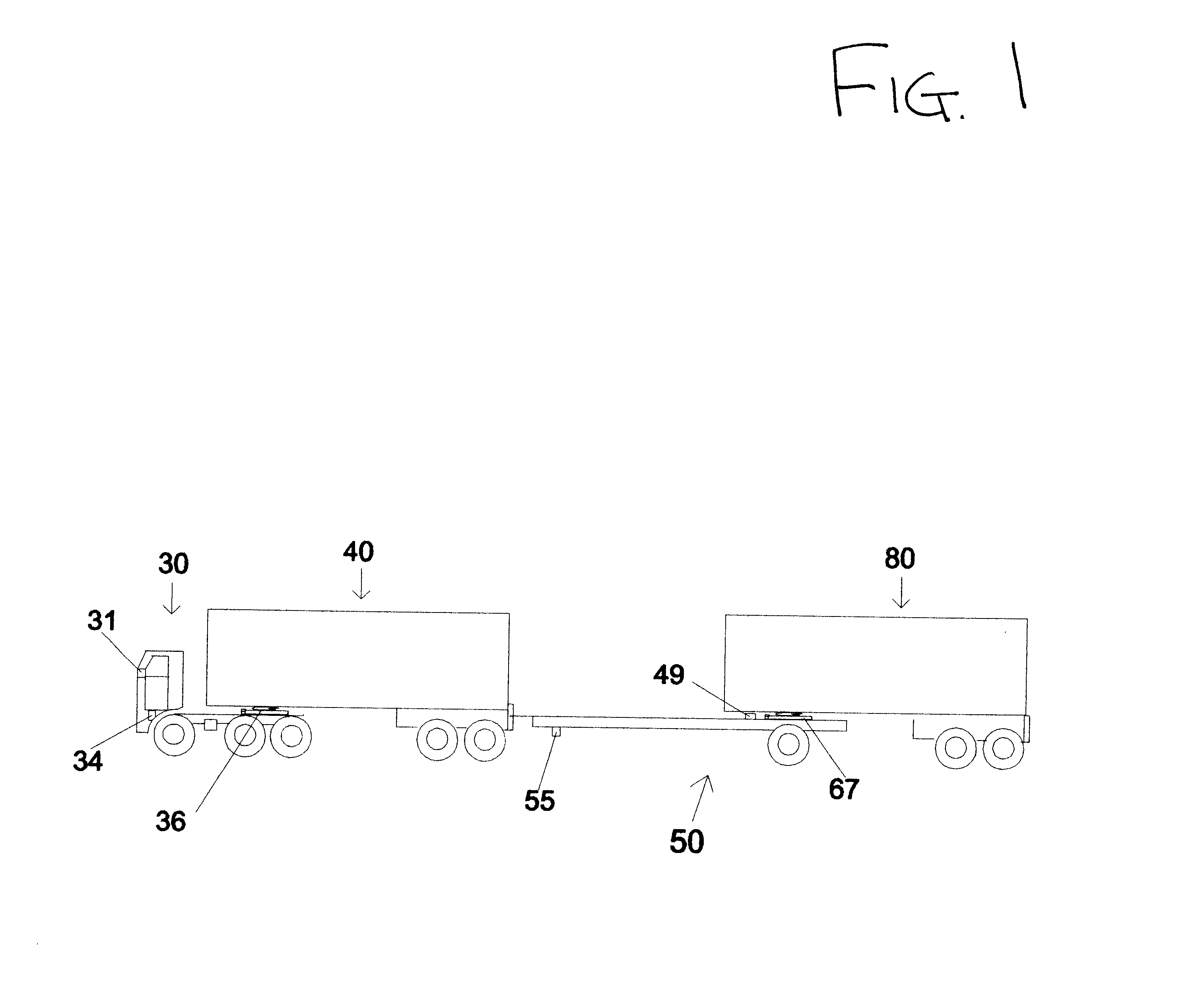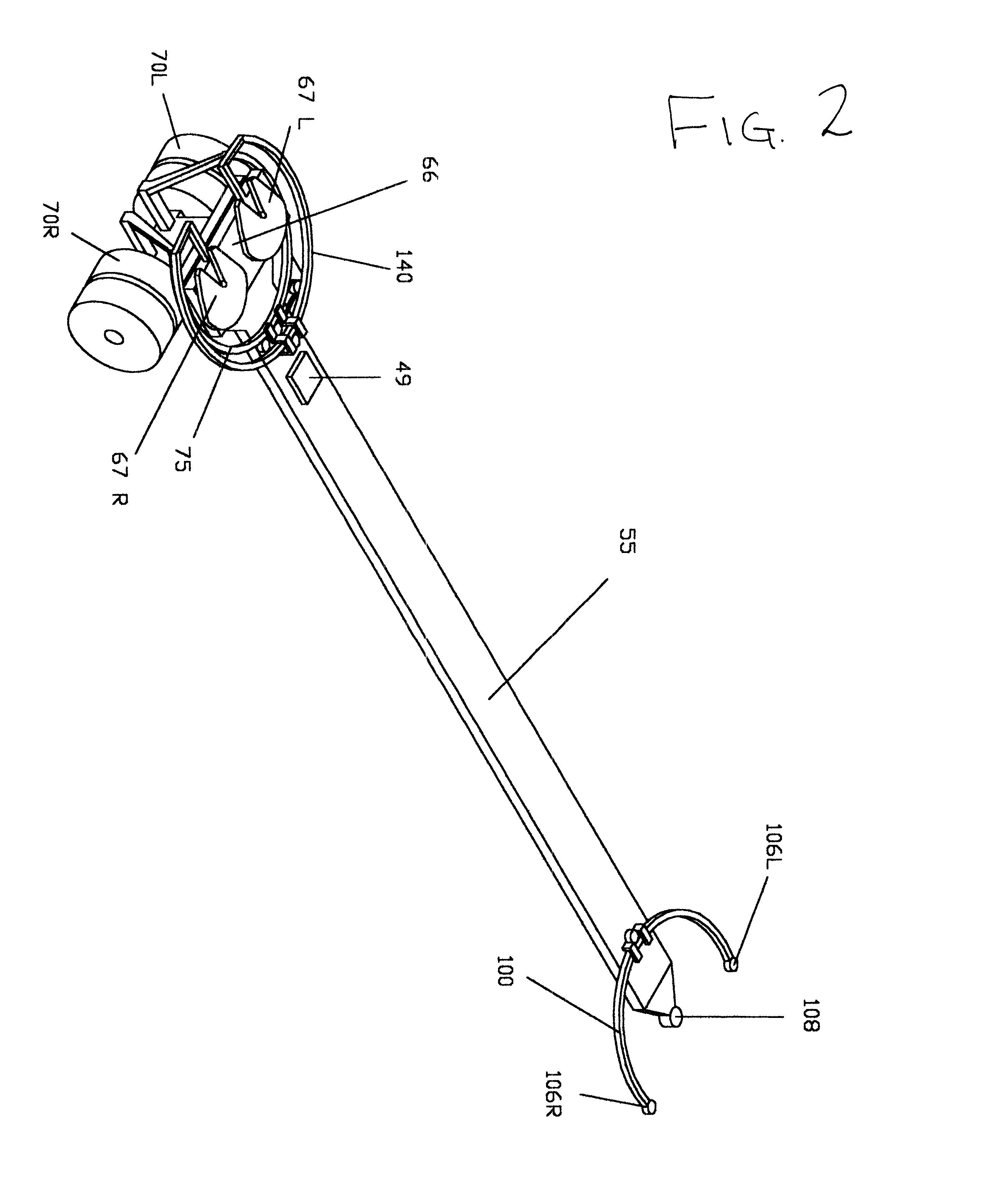Robotic vehicle that tracks the path of a lead vehicle
a robot vehicle and lead vehicle technology, applied in the field of robot vehicles, can solve the problems of lack of maneuverability, difficulty in comparing with other freight haulers, and inability to maneuver,
- Summary
- Abstract
- Description
- Claims
- Application Information
AI Technical Summary
Problems solved by technology
Method used
Image
Examples
first embodiment
the invention has a long rigid main robotic tractor frame or tongue 55, which is the central rigid structural member. The front of the tongue 55 is attached at hitch latch 108 to the forward trailer 40.
At the rear of the robotic tractor there are three sections which each pivot in relation to each other, with a single vertical pivot point, best seen in FIG. 3. The uppermost section is a trailer mounting bar 66 with its two attached fifth wheels 67 L, R. The middle section is the robotic tractor frame or tongue 55. The lowest section is a steering axle assembly 60 with attached running wheels 70 L, R.
In the uppermost section, the trailer mounting bar 66 is free to swivel around the trailer mounting bar central pivot 65 (FIG. 3). This trailer mounting bar 66 pivots above the tongue 55 and around the same line as the steering axle assembly central pivot 58. Mounted on this trailer mounting bar 66 are the two fifth wheel latches 67 L, R by which the rear trailer 80 will be coupled to th...
second embodiment
PREFERRED SECOND EMBODIMENT OF INVENTION
FIGS. 8 and 9 show a robotic tractor with path tracking steering, variable ratio with oversteer steering, and traction kinking that is a preferred embodiment of the invention. This embodiment differs from the simpler robotic tractor with path tracking of the first embodiment in several ways. The robotic tractor length can be adjusted in this embodiment. The robotic tractor tongue is split into two parts, 55a and 55b, and 55b can be extended or retracted at the joint 144, with the pin and lock set 146 holding it in place. This embodiment also uses traction kinking to assist in turning corners. This embodiment uses two separate path tracking modes, relative angle path tracking mode and rate of orientation change path tracking mode, instead of only the relative angle path tracking mode used in the first embodiment of the invention. Also, the variable ratio with oversteer steering mode is included in the combination of steering modes to allow the ...
third embodiment
FIG. 14 shows a double-axle trailer or wagon that utilizes path tracking and variable ratio with oversteer mode steering with traction kinking. This wagon is designed to be pulled in a "Multiple Wagon Train" configuration behind a three-quarter ton pickup or some such vehicle, so it will be accordingly sized down somewhat from the robotic tractor with path tracking steering, variable ratio with oversteer and traction kinking discussed as the complex embodiment above. As was true for the robotic tractor however, this wagon will require three hitch balls on the towing vehicle. The second wagon in the train will use as input the orientation information from the upper 140 and lower partial circular tracks 75 of the first wagon in the train. The steering system for this wagon is identical to that for the robotic tractor except that control and shifting by the driver and the controlling microprocessor or computer 49 will utilize 12 volt solenoids and / or 12 volt DC motors instead of the ai...
PUM
 Login to View More
Login to View More Abstract
Description
Claims
Application Information
 Login to View More
Login to View More - R&D
- Intellectual Property
- Life Sciences
- Materials
- Tech Scout
- Unparalleled Data Quality
- Higher Quality Content
- 60% Fewer Hallucinations
Browse by: Latest US Patents, China's latest patents, Technical Efficacy Thesaurus, Application Domain, Technology Topic, Popular Technical Reports.
© 2025 PatSnap. All rights reserved.Legal|Privacy policy|Modern Slavery Act Transparency Statement|Sitemap|About US| Contact US: help@patsnap.com



